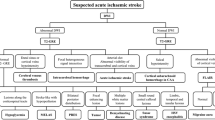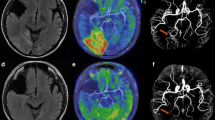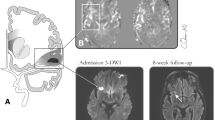Abstract
Although a perturbed cerebral blood flow (CBF) has been reported in patients with Wernicke’s encephalopathy (WE), its clinical meaning is still elusive. A retrospective analysis of 10 patients (male, 6; mean age, 57.7 years) with WE between October 2012 and May 2018 was performed. Brain imaging was performed using fluid-attenuated inversion recovery (FLAIR), diffusion-weighted imaging (DWI), arterial spin labeling (ASL) perfusion-weighted imaging (PWI), and contrasted enhanced T1-weighted imaging. All patients had symmetric high signal intensity lesions in the vulnerable areas on FLAIR or DWI with focal hyperintensity on ASL-PWI (100% sensitivity). CBFlesion was variable (from 70 mL/100 g/min to 190.0 mL/100 g/min). CBFlesion/CBFwhite matter was elevated, ranging from 2.5 to 5.5. Focal hyperintensity on ASL in the vulnerable areas can be a diagnostic clue for WE.

Similar content being viewed by others
References
Manzo G, De Gennaro A, Cozzolino A, Serino A, Fenza G, Manto A (2014) MR imaging findings in alcoholic and nonalcoholic acute Wernicke’s encephalopathy: a review. BioMed Res Int. 2014:503596
Jung YC, Chanraud S, Sullivan EV (2012) Neuroimaging of Wernicke’s encephalopathy and Korsakoff’s syndrome. Neuropsychol Rev. 22:170–180
Shogry ME, Curnes JT (1994) Mamillary body enhancement on MR as the only sign of acute Wernicke encephalopathy. AJNR Am J Neuroradiol. 15:172–174
Matsuda K, Yamaji S, Ishii K, Sasaki M, Sakamoto S, Kitagaki H et al (1997) Regional cerebral blood flow and oxygen metabolism in a patient with Korsakoff syndrome. Ann Nucl Med. 11:33–35
Hakim AM (1986) Effect of thiamine deficiency and its reversal on cerebral blood flow in the rat. Observations on the phenomena of hyperperfusion, “no reflow,” and delayed hypoperfusion. J Cereb Blood Flow Metab. 6:79–85
Grade M, Hernandez Tamames JA, Pizzini FB, Achten E, Golay X, Smits M (2015) A neuroradiologist’s guide to arterial spin labeling MRI in clinical practice. Neuroradiology. 57:1181–1202
Yoo RE, Yun TJ, Yoon BW, Lee SK, Lee ST, Kang KM et al (2017) Identification of cerebral perfusion using arterial spin labeling in patients with seizures in acute settings. PloS one. 12:e0173538
Navarro D, Zwingmann C, Hazell AS, Butterworth RF (2005) Brain lactate synthesis in thiamine deficiency: a re-evaluation using 1h-13c nuclear magnetic resonance spectroscopy. J Neurosci Res. 79:33–41
Desjardins P, Butterworth RF (2005) Role of mitochondrial dysfunction and oxidative stress in the pathogenesis of selective neuronal loss in Wernicke’s encephalopathy. Mol Neurobiol. 31:17–25
Bhan A, Advani R, Kurz KD, Farbu E, Kurz MW (2014) Wernicke’s encephalopathy mimicking acute onset stroke diagnosed by CT perfusion. Case Rep Neurol Med. 2014:673230
Funding
No funding was received for this study.
Author information
Authors and Affiliations
Corresponding author
Ethics declarations
Conflict of interest
The authors declare that they have no conflict of interest.
Ethical approval
All procedures performed in the studies involving human participants were in accordance with the ethical standards of the institutional and/or national research committee and with the 1964 Helsinki Declaration and its later amendments or comparable ethical standards.
Informed consent
For this type of study, formal consent is not required.
Additional information
Publisher’s note
Springer Nature remains neutral with regard to jurisdictional claims in published maps and institutional affiliations.
Rights and permissions
About this article
Cite this article
Ko, SB., Kim, T.J. & Sohn, CH. Focal hyperemia in Wernicke’s encephalopathy: a preliminary arterial spin labeling MRI study. Neuroradiology 62, 105–108 (2020). https://doi.org/10.1007/s00234-019-02298-7
Received:
Accepted:
Published:
Issue Date:
DOI: https://doi.org/10.1007/s00234-019-02298-7




